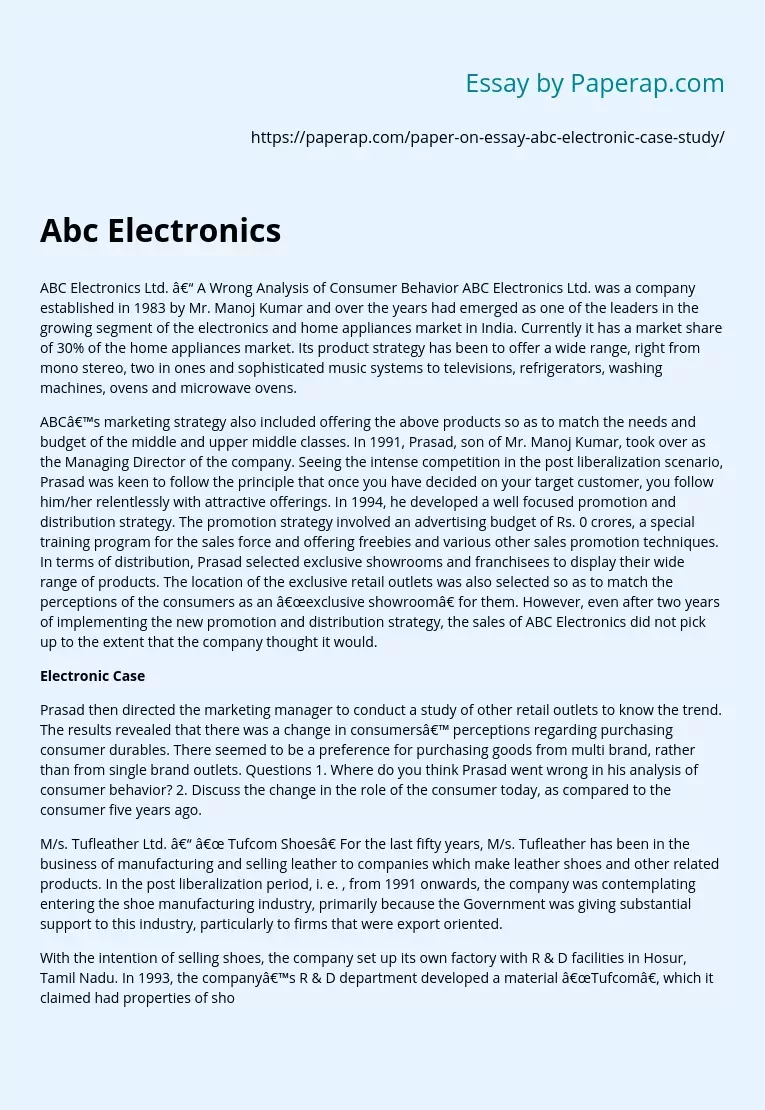A Wrong Analysis of Consumer Behavior
ABC Electronics Ltd. was a company established in 1983 by Mr. Manoj Kumar and over the years had emerged as one of the leaders in the growing segment of the electronics and home appliances market in India. Currently it has a market share of 30% of the home appliances market. Its product strategy has been to offer a wide range, right from mono stereo, two in ones and sophisticated music systems to televisions, refrigerators, washing machines, ovens and microwave ovens.
ABC’s marketing strategy also included offering the above products so as to match the needs and budget of the middle and upper middle classes.
In 1991, Prasad, son of Mr. Manoj Kumar, took over as the Managing Director of the company. Seeing the intense competition in the post liberalization scenario, Prasad was keen to follow the principle that once you have decided on your target customer, you follow him/her relentlessly with attractive offerings. In 1994, he developed a well focused promotion and distribution strategy.
The promotion strategy involved an advertising budget of Rs. 0 crores, a special training program for the sales force and offering freebies and various other sales promotion techniques. In terms of distribution, Prasad selected exclusive showrooms and franchisees to display their wide range of products. The location of the exclusive retail outlets was also selected so as to match the perceptions of the consumers as an “exclusive showroom” for them. However, even after two years of implementing the new promotion and distribution strategy, the sales of ABC Electronics did not pick up to the extent that the company thought it would.
Prasad then directed the marketing manager to conduct a study of other retail outlets to know the trend. The results revealed that there was a change in consumers’ perceptions regarding purchasing consumer durables. There seemed to be a preference for purchasing goods from multi brand, rather than from single brand outlets. Questions 1. Where do you think Prasad went wrong in his analysis of consumer behavior? 2. Discuss the change in the role of the consumer today, as compared to the consumer five years ago.
M/s. Tufleather Ltd. – “ Tufcom Shoes” For the last fifty years, M/s. Tufleather has been in the business of manufacturing and selling leather to companies which make leather shoes and other related products. In the post liberalization period, i. e. , from 1991 onwards, the company was contemplating entering the shoe manufacturing industry, primarily because the Government was giving substantial support to this industry, particularly to firms that were export oriented.
With the intention of selling shoes, the company set up its own factory with R & D facilities in Hosur, Tamil Nadu. In 1993, the company’s R & D department developed a material “Tufcom”, which it claimed had properties of shoe material permeability, strength, flexibility and durability. The company also set up a sub unit to produce shoes with this new material and conducted test marketing to gauge the initial response. The pilot study indicated positive consumer response.
Based on the test marketing results, the company set up a large plant with a huge investment and entered into tie ups with reputed shoe manufacturers to buy the new material and make attractive shoe models. They also planned to have an in-house trained team of sales people who would visit the shoe retail outlets and train their sales persons on how to sell shoes. Tufleather also helped the shoe manufacturing companies by providing point of purchase and advertising materials for a nationwide advertising campaign.
The company developed a premium pricing strategy for the Tufcom material, based on the consumer perceptual process – the belief that high price is an indicator of high quality. They felt that Tufcom offered quality that was superior to leather in terms of durability and ease of care. After adopting a skimming pricing strategy, the company would later consider penetrating the lower priced shoe market segment. While the first year after the launch of Tufcom shoes showed positive results, sales began to fall drastically after that.
Feedback from their sales team indicated that high price buyers did not get motivated by the factors emphasized by Tufleather, namely durability and ease of care. In addition, some complaints were received from buyers of Tufcom shoes that they found the shoes unusually warm. Questions 1. Where do you think the company went wrong in analyzing consumer shoe buying behavior? 2. Do you think the company should identify a new buyer market, namely the lower priced shoe market segment?
A Wrong Analysis of Consumer Behavior. (2019, Dec 05). Retrieved from https://paperap.com/paper-on-essay-abc-electronic-case-study/

